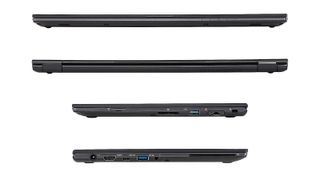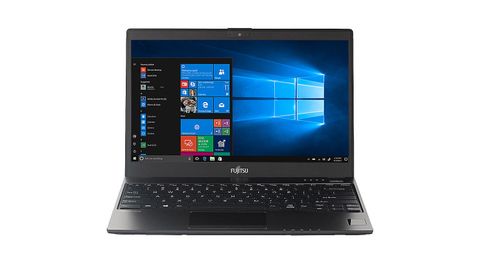Why you can trust TechRadar
Specifications
Here is the Fujitsu Lifebook U938 configuration sent to TechRadar Pro for review:
CPU: Intel Core i5-8350U quad-core 1.7GHz
Graphics: Intel HD Graphics 620
RAM: 8GB DDR4 RAM (2133MHz)
Screen: 13.3-inch Full HD touchscreen
Storage: 256 GB PCIe NVMe SSD
Ports: 2 x USB 3.1 Type-A Gen 1, 1 x USB 3.1 Type-C (with Power Delivery), 1 x HDMI, microSD card slot, SIM card slot, 1x (pull out) Ethernet, headphone/mic jack, SDHC card slot, SmartCard reader
Connectivity: 802.11ac Wi-Fi, Bluetooth 4.2, LTE
Camera: Built-in webcam (HD)
Weight: 920g
Size: 309.3 x 213.5 x 15.5mm (W x D x H)
Battery: 4-cell, 50Wh (3490 mAh)
Simply put, the specifications of the U938 are stellar. And, for those that want even more power, Fujitsu offers a Core i7 version in this range.
Even with the Core i5, there is plenty of computer power in such a super-lightweight magnesium shell, though the Lifebook manages to remain almost silent irrespective of the tasks demanded of it.
While 256GB of drive storage might seem modest, it is at least the very best NVMe technology that kicks a SATA SSD to the kerb. Those wanting to reduce the price can go with SATA, with sizes ranging from 128GB to 512GB. But sadly, whichever technology you choose, the maximum drive size is 512GB.
The 8GB of 2133MHz DDR4 RAM is more than adequate for average tasks, and this can be increased to 20GB at the point of purchase.
For those wondering if the memory and storage could be user enhanced, the manual states quite clearly that: ‘Unauthorized opening or incorrect repair may greatly endanger the user (electric shock, fire risk) and will invalidate your warranty.’
Another optional item installed in the factory is the palm vein sensor, which can be swapped out for a fingerprint sensor in some regions.
Something of a curiosity we should mention is the fold-out Ethernet port. For those who have yet to encounter one of these, it’s an odd solution that allows a laptop which is too thin to mount a proper RJ45 connector to fudge this issue.

Once prised out with a fingernail, the flattened frame hinges to allow an Ethernet cable to dock to a structure that was previously too narrow.
To our eyes, it looks like the very first part that will break on the U938, even if it is a remarkably clever design.
We’d recommend anyone who wants Gigabit Ethernet in the office to buy the USB Type-C connected docking station, and connect an Ethernet cable to that instead.
For those on the move, the optional LTE module could be critical, assuming the local LTE services are those you can access.
Performance
Here’s how the Fujistsu Lifebook U938 performed in our suite of benchmark tests:
Passmark: 2986.6
Passmark CPU: 8050
CPU-Z: 416.8 (single-thread); 1641.1 (multi-thread)
Geekbench: 4276 (single-core); 11376 (multi-core); 19739 (compute)
Cinebench: OpenGL: 47.12 fps; CPU: 499
CrystalDiskMark: 3314.6 MBps (read); 1223.3 MBps (write)
Novabench: 1358
Atto: 3084 MBps (read, 256mb); 1223 MBps (write, 256mb)
Sisoft Sandra (KPT): 8.35
Unsurprisingly the U938 in the review trim is an excellent performer.
The inclusion of an NVMe drive on the review model made a huge difference to the drive-related scores, demonstrating that when connected to mains power, this machine will easily outperform most desktop PCs.
The SSD on the review machine was the Enterprise OEM Samsung P961, a V-NAND MLC design that numerous system builders have embraced. It’s very strong on read performance, and less wonderful at writing. But it still manages to be double the speed of the best SATA SSD drives.
As a computing platform, the U938 feels a little geared down from its full potential, possibly to extend battery life. We’ve seen faster machines built around the slightly slower Intel Core i5-8250U CPU, where the configuration is being less careful about battery life and cooling.
But as mobile platforms go, this is still a very powerful one that can breeze through most office-related duties with ease.
Unless you intend to make fluid dynamics calculations or some other super-intensive task, the U938 will be more than adequate to the task.
However, if there is a blot on the beautifully maintained Fujitsu landscape, it’s the battery life that you can reasonably expect with such a high specification machine. In its brochure, Fujitsu describes the U938 as having ‘all-day battery runtime’, which from our testing seems mildly optimistic.

Using the PCMark08 Work test the machine had a projected battery life of 4 hours 6 minutes. In a real-world scenario, we’d expect it to last longer, but probably not twice as long.
This minor weakness is the flip-side of making this machine both light and powerful, and to expect otherwise is unrealistic.
Also, if you use it every day, the battery is rated to 500 recharge cycles, suggesting that you’ll need a replacement battery before two years is up.

In addition to our normal testing, we also ran a screen analysis that determined a gamut of 97% of sRGB. For a laptop, that’s a terrific result, although as it only represents 75% of AdobeRGB, it isn’t a screen that we’d recommend for color-corrected photos.
Final verdict
The combination of power and performance in the Fujitsu Lifebook U938 is a little intoxicating, if not taken in moderation.
When you factor in the portability of the machine, this becomes the sort of equipment that makers are forced to wrestle back from reviewers, possibly using a ladder or some other tag-team equipment to subdue them.
Parts of it could have been more robustly made, we’re sure, but this is a pure thoroughbred, not a cart horse.
One issue with the Lifebook that we’d hoped to see less of these days is the number of irritating applications the maker decided to pre-install.
Some of them proved so annoying - we’re looking at you, McAfee Livesafe - that we were forced to remove those merely to complete our benchmarks without being repeatedly interrupted by seemingly endless panic-inspiring alerts.
In a business environment all this junk will almost certainly be removed before the user ever sees it, so why bother installing it in the first place?
But whatever the reason, we wish Fujitsu and others would just stop this practice, as it simply irritates reviewers, IT personnel and customers alike.
But niggles aside, there are so many great things about this machine, especially if you want something easy to carry and bristling with useful features. Something this well-engineered, designed and built was never going to be cheap, but it is probably worth every penny.
- Also take a look at the best business laptops of 2018
Mark is an expert on 3D printers, drones and phones. He also covers storage, including SSDs, NAS drives and portable hard drives. He started writing in 1986 and has contributed to MicroMart, PC Format, 3D World, among others.

Amazon Prime Video's disappearing act could point to a future without the service

Tesla Cybertruck suffers new recall for a very scary problem

'The party is over for developers looking for AI freebies' — Google terminates Gemini API free access within months amidst rumors that it could charge for AI search queries

